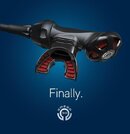I concur, I'm not too fond of the second stage housing on the Hollis version either but that is primarily aesthetics. Here is an image of the Omega III that is
supposed to be released soon:

As for a wet breather, I find it the same as all side exhausts including Poseidon, AGA, and the few Teknas I have used. I am just trying to understand your comment since you are an experienced side-exhaust diver and I have always respected your posts.
Part of my predive trip tests has always been to suck on the mouthpiece with the first stage capped to verify the exhaust valve and diaphragm seating. I have never perceived any leakage on any side exhausts that I can remember. Like all regulators, water leaks in past your lips and blows out the exhaust. As you know, side exhausts require the exhaust to be level or tilting down for the water to exit. Aside from technique, I don’t understand how there is any difference in wetness.
Sort of thinking aloud here: Whenever I notice a little wetness in any regulator with a mouthpiece (as opposed to a hat or mask), I tighten my lips around the mouthpiece and it stops. I am guilty of holding the mouthpiece very loosely though. I often notice gas blowing out past my lips regardless of regulator design. No doubt water is entering with such a lazy grasp on the mouthpiece.
The internal ports on the Omega’s main servo-activated valve are a radial series of holes near the mouthpiece so the only way water can be picked up by the gas stream is if there is a lot of water in there and the exhaust is a higher than the inlet (so water can pool around the ports). There is an initial high-flow blast of gas on servos as that large main valve opens that might be more likely to pick up water if it isn’t dry near the ports. I like the slight sense of being inflated at the beginning of inhalation, but it can be disconcerting if you aren’t used to it though.
The biggest downside of what I consider to be an exceptionally simple and elegant design is the tiny ports in the servo valve system. It is a non-issue for Scuba but would be a problem in surface supplied where the air stream is not nearly so particle free. Since the hole through the valve diaphragm in the main valve is so tiny and feeds the larger servo valve, a particle-clog will cause wide-open free-flow. The advantage for surface supplied is the second stage breathes easily with a broad range of inlet pressure. I doubt they ever tested it beyond normal IP ranges, that is just an uncalibrated personal estimate. I have used it with 80-175 PSI over bottom pressure and didn’t detect increased resistance or leakage.
I did zero maintenance to an Omega second stage for 27 years as a test, beyond rinsing in fresh water. There is only one, albeit tiny, spring where calibration isn’t very critical. There are basically only two moving parts, the servo valve lever (with spring) and the deflecting main valve rubber disk or diaphragm. I am not sure that tests on an ANSI breathing machine were ever done on the Tekna so it is hard for me to make any quantitative comparisons.
Do you have any thoughts on what could make the Omega feel like a wetter breather than the Tekna?








